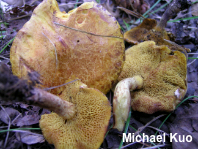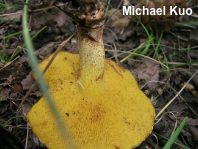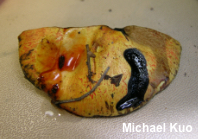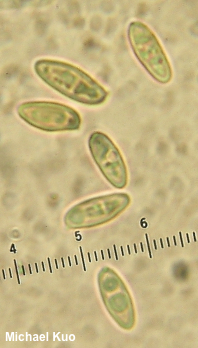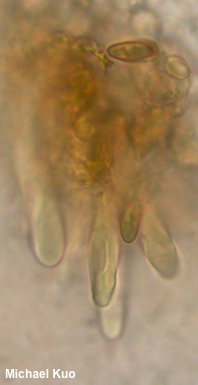| Major Groups > Boletes > Suillus > Suillus americanus pseudosibiricus |

|
Suillus americanus pseudosibiricus [ Basidiomycota > Boletales > Suillaceae > Suillus . . . ] by Michael Kuo This is the western North American form of Suillus americanus, which is currently defined broadly as a morphologically variable species associated with various 5-needled pines on three continents. Like other forms of the species, Suillus americanus pseudosibiricus features a sticky yellow cap adorned with red fibrils and marginal veil remnants, a yellow-then-brownish pore surface, and a tough stem with glandular dots. What separates form pseudosibiricus is primarily its range and its mycorrhizal associates (western white pine and limber pine)—although, in comparison to other forms of the species, its cap tends to be a duller shade of yellow and more prone to development of brownish scales, and its stem is often slightly wider. "Suillus sibiricus" in the sense of western North American authors is a synonym. Description: Ecology: Mycorrhizal with western white pine and limber pine; growing scattered or gregariously; late summer and fall; originally described from Arizona; widespread in western North America wherever the host trees occur. The illustrated and described collections are from Colorado. Cap: 5–8 cm across; convex with an inrolled margin when young, but soon broadly convex to flat; slimy to sticky when fresh; bright yellow to dull yellow, with scattered red fibrils; becoming sub-scaly with brownish scales in dry conditions or at high elevation; the margin with whitish to brownish veil remnants. Pore Surface: Yellow, becoming brownish; bruising slowly brown to pinkish brown; pores angular and vaguely radially arranged (but not boletinoid), Stem: 3–5 cm long; 1–1.5 cm thick; equal; yellow above and brownish yellow to brownish below; with brown to reddish brown glandular dots; usually lacking a ring or ring zone; basal mycelium whitish to pinkish. Flesh: Yellow throughout, but darker yellow in the stem; staining slowly pinkish when sliced. Odor and Taste: Not distinctive. Chemical Reactions: Ammonia red on cap surface; red on flesh. KOH black on cap; black on flesh. Iron salts negative on cap; greenish gray on flesh. Spore Print: Cinnamon brown. Microscopic Features: Spores 8–10.5 x 3–4 µm; boletoid-fusiform; smooth; hyaline to yellowish in KOH. Basidia 20–26 x 4–6 µm; subclavate; 4-sterigmate. Cystidia in bundles; sometimes poorly defined individually; 35–60 x 4–7 µm; cylindric or subclavate; thin-walled; brown in KOH. Pileipellis an ixocutis; elements 3–8 µm wide, smooth, hyaline in KOH. REFERENCES: W. Klofac, 2020. (Smith, 1949; Smith & Thiers, 1964; Smith, 1975; Thiers, 1975; Thiers, 1979; Smith, Smith & Weber, 1981; Arora, 1986; States, 1990; Phillips, 1991/2005; Klofac, 2013; Cripps, Evenson & Kuo, 2016; Nguyen et al., 2016; Klofac & Krisai-Greilhuber, 2020.) Herb. Kuo 08150717. This site contains no information about the edibility or toxicity of mushrooms. |
© MushroomExpert.Com |
|
Cite this page as: Kuo, M. (2022, September). Suillus americanus pseudosibiricus. Retrieved from the MushroomExpert.Com Web site: http://www.mushroomexpert.com/suillus_americanus_pseudosibiricus.html |
